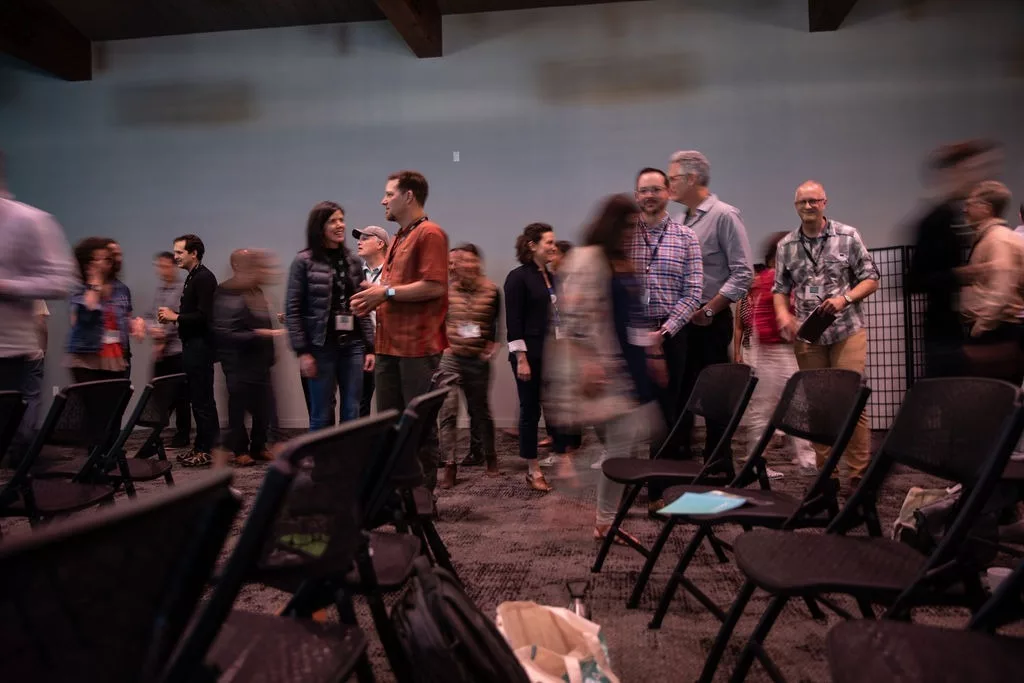Image from 2019 Conscious Company Leaders Forum, photo by Caitlin Eddolls Photography
Ever hear the expression, “It’s not what you know, it’s who you know”? Very, very likely the answer is yes. And you may be thinking that having a large network or a huge number of relationships is how you’ll show that expression who’s boss.
But what if I told you that you don’t need a huge network to accomplish your goals; you just need an impactful one. Like so much that governs the world around us, there’s a science to relationships and networks. In this article, we’ll explore the science behind networks in order to help you better understand (and grow) your own.
Step 1.
Know that networking is a numbers game — just not how you think it is.
Did you know there’s a physical limitation to how many relationships we can maintain? Evolutionary psychologist and anthropologist Robin Dunbar, through his study of primates and vampire bats, discovered that the size of the neocortex (a portion of the brain that performs higher functions like spatial reasoning, among other things) directly impacts the number of relationships that an animal can maintain. And as it turns out, this is true for humans, as well; 150 is the magical number of relationships a person can manage. Technically we can recognize more names and faces than this (1,500 if we’re getting specific), but 150 is the number of active, meaningful relationships we can maintain at any point in our lives.
Not all relationships are created equal. Some, like those with our significant others and family members, involve much stronger bonds than a colleague who we catch up with over coffee every couple of months. To better understand how this is structured, imagine a series of circles, layered inside one another. The outermost layer represents the circle of 150 relationships, the next represents 50, the next 15, and the last one 5. The closer inside of the circles we move, the better and more intimately we know the person. Time, experience, and trust are the greatest barriers to entry for our closest and most guarded circles of 5 and 15.
Now here’s the reason this is valuable to know: you are curating your network. If you only have meaningful space and capacity for 150 people (including your family and friends), then which are the relationships you want to spend your remaining time and bandwidth fostering?
Step 2.
Learn the value of weak ties.
While we spend about 60 percent of our time with those in our circles of 50, 15, and 5, new information and opportunities come to us through something called a “weak tie.” A weak tie is someone we label as an “acquaintance,” and they’re most likely residing inside of your circle of 150. Because they spend most of their time inside of the circles of others, they hold different information and have new people they can introduce you to than those you know most intimately (as you likely share the same friend group and family as those in your most intimate circles). They might know of job opportunities or contract work, people you should connect with, etc., but these opportunities will remain out of reach if you don’t make a practice of spending time connecting with those in your outer circle.
Step 3.
Understand the value of dormant relationships.
Your circles aren’t set in stone. For example, those who were part of your circle of 150 in elementary school (fellow classmates, teachers, etc.) are unlikely to still be inside of this circle 20, 30, or 40+ years later. You may have one or two friends whom you’ve remained in close contact with, but most likely the boy who sat behind you in history class is now a mystery to you. In so many ways, it’s the age old principle of “out of sight, out of mind.” When we stop nurturing or fostering a relationship, these relationships slide outside of our circles; sometimes they move to a less intimate circle and sometimes they’re removed entirely.
But here’s where the dormant relationship enters the picture: although you haven’t remained in touch and it may have been 20 years since you’ve connected with a former boss or colleague, trust was established from your time together inside of one another’s circle. It is far easier and less time-consuming to reactivate a dormant relationship than to create an entirely new one because you already have established trust.
Now that we’ve laid the groundwork for the science behind relationships, let’s explore how to strengthen a casual conversation into a meaningful relationship.
Step 4.
Ask open-ended questions.
How many times have you been to a networking event and seen a person fluttering around the room distributing business cards after a two-or-so-minute conversation with every person who enters?
While this person might have distributed numerous business cards, do you think any of those people they introduced themselves to will remember them well enough to put that business card to use?
It is far more efficient to invest your time at an event with a small handful of people than to try to meet everyone in the room. If you’re able to have an actual conversation with a person, you’ll have far more context upon which to follow up and to build a relationship.
One of the best ways to really connect and engage with someone at an event is to ask open-ended questions, but not all questions are equally effective. Some, like “What do you do?” are better asked later inside of a conversation; if asked immediately you run the risk of distancing yourself from your conversational partner. Most likely you’re at an event right after traditional work hours and the person you’re chatting with has just left the office — and wants to leave it behind for the day. A better place to start is with a more topical question related to the context of why you’re at the same event, like “What brings you to this event?” or “Have you been to one of these events before?”
And if you’re reading this and thinking, “But I hate small talk,” here’s more science for you. Through a fascinating study where couples were monitored in an apartment-like environment, John Gottman, Ph.D., developed an explanation for how we connect emotionally. In the most basic sense, we send out “bids” for connection. And when we’re in a conversation with someone new, we’re sending out bids to see whether or not this person is safe — if we can trust them or if they’re making the hair on the backs of our necks raise, triggering our fight or flight response. Turns out “small talk” is the device that we use to bid back and forth and establish whether or not someone is safe.
Step 5.
Actually follow up.
Of everything shared thus far, this is the shortest and sweetest. If you had a conversation with someone and you want to build the relationship, follow up. There’s no shortcut for time and experience; if you want to develop this connection into a relationship that’s inside of your circles, you have to get to know them better. You can cater this toward your strengths; for example, you can invite someone to coffee if you’re best at sharing one-on-one or you can email them a relevant article about something you discussed when you met.
The simple act of following up will continue what you started when you met (a.k.a., all of the heavy lifting), so what are you waiting for?




